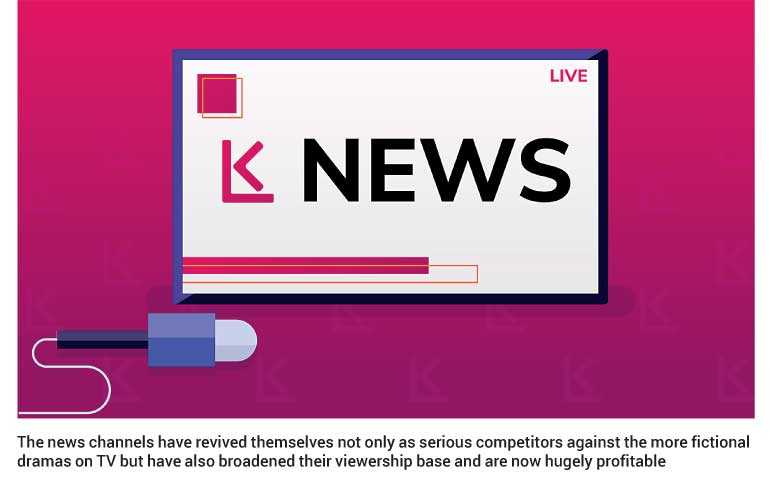Thursday Apr 03, 2025
Thursday Apr 03, 2025
Wednesday, 6 November 2019 00:00 - - {{hitsCtrl.values.hits}}

 We had one TV channel in India till the 80’s. Then overnight we had 100% more – two. And then from the 90’s we had satellite TV and hundreds of channels to choose from.
We had one TV channel in India till the 80’s. Then overnight we had 100% more – two. And then from the 90’s we had satellite TV and hundreds of channels to choose from.
I remember sitting in college and a friend who recently returned from the ‘Big Apple’ described at length about a music channel on TV in the US that ran 24x7. “It’s called MTV,” he said. Our mind boggled at the thought of a music channel that eked out dire straits, Pink Floyd and Eric Clapton as fare day in and day out.
In a few years, MTV came to India too. As did CNN and BBC and all the others. Local TV networks sprung up too. And the battle lines for capturing the Indian TV viewers’ time and attention were drawn. English soap and serials competed with locally produced content.
Different strategies were drawn by high quality marketing people to gain share of the eyeballs. Measured in TRPs. This TRP Data was determined by the research companies which had scientific methods, tried and tested worldwide to determine people’s TV viewing habits.
This involves giving the people for this exercise a remote for the household – different members of the household (male/female/young) would need to use a different button on the remote while they surfed channels and programs.
This accumulated data along with hundreds of other panellists would provide the research agency with rich data determining viewer choices and preferences with regards to TV programs, channels and genres. This data was gold for TV channels as they used this information to sell time on their networks to advertisers and brands.
TV time sellers would visit media planners furnished with viewership data to ensure the planners would recommend their TV network to their clients in their plans for any ensuing campaign. Simplistically put, a program or TV channel with greater TRPs would be certain to get more advertising traffic and therefore make more money.
Thus derived the term – pandering to TRPs, which means tailoring content to ensure more people watched the program which of course resulted in more advertising traffic and therefore more revenue in the TV channel coffers.
In the initial days, there were two or three broad genres of programming which had very clear predetermined viewership – entertainment channels (soaps, music and movies) watched primarily by women but very often men and other members of the family joined in as this was quality time spent together.
Then there were sports (primarily viewed by men and the young) with some occasional women participation, and then finally news which was primarily older men viewership. News on TV mirrored a newspaper. Clearly it was serious stuff. Lots of information presented factually albeit in a boring way.
For many years I have never watched news on TV. All it did was show political speeches. But there were big moments like the passing away of a famous leader or a big sporting event that would have us all glued to the news. Despite this, news was not getting the TRPs it needed to sustain itself in the TV viewing market place.
I remember as part of an agency team in a pitch for the NDTV business – our key recommendation after looking at how to market a news channel was – broad base the appeal of news to the whole family. Our assessment, as would have been the assessment of all agency’s presenting to NDTV possibly was – the only way for news channels to thrive was to compete with entertainment channels.
Get viewership from prime time soaps, ensure the content appeals to everyone, and find ways to make news more exciting. Not the dull monotone style of information presentation but one that focuses on what we called lifestyle stories (some gossip, some topical interest stories that attract women viewership).
We never got the NDTV business. But it’s very clear that the news channels had heard the news. Either they had to spruce up their content to broaden their appeal to a larger target group or risk losing their viewers to entertainment channels and sports channels.
News channels provide great examples of how to understand consumer needs and tailor the product on a regular basis to a constantly changing consumer base and on how to use the advent of social media like Twitter to feed into their viewership and develop a meaningful symbiotic relationship
The development of news channels
The battle was joined. News channels on TV started tailoring their content to attract a broader base of audiences – Breaking News became a feature. This created the excitement needed to involve viewers. Something was happening. And people wanted to see what it was, and be able to talk about it. The ticker tape at the bottom of the screen was introduced. This had a combination of political news and juicy Bollywood gossip. This would keep the viewer tuned in to hear the news for longer.
Branded programs that featured aggressive debates made its way into TV screens. The drama of soaps was now on the news channels. Then localised news based on sensational stories like a child falling into a bore well or a scandal in an ashram or a fire in the local market.
These besides the stories of crime, cricket and Bollywood kept the news genre active and engaged with viewers. And then the ‘shouting anchors’. Ones who you would perhaps stay away from in a public group but makes for dramatic and sensational TV viewing. Personally I avoid these shows. But over time TRP ratings have proven the monetary worth of these marketing efforts.
The news channels have revived themselves not only as serious competitors against the more fictional dramas on TV but have also broadened their viewership base and are now hugely profitable. The internet revolution and advent of Twitter has further challenged TV news and the tactics now includes outrage marketing.
A lot of Twitter trends tend to be based on generating outrage at a social issue or a racial slur or politician doing something unforgivable. It goes viral, the hashtag trends, bringing in more points of view and therefore more audiences into a discussion.
TV news has capitalised on this trend to bring in audiences from online platforms on to their channels or online sites. Any trending topic is likely to be featured prominently on TV news and discussed with ‘expert’ panels and the viewer watching it agrees with one point of view, and aggressively and vicariously expresses their disdain through the voices of the panellists and feels like they have in some way contributed to resolving the issue.
The way this works is simple – get more retweets or likes or shares/comments and these are monetising factors for the networks. Viewers tend to respond spontaneously to outrage – it hooks them into the issue and keeps them engaged for a short time. Till a new outrage is discovered. And yet again the viewers’ attention is retained and monetised.
One just needs to watch American or Indian news channels to see this in action. Purists, even some journalists, would have strong views on whether news should be treated this way – as a product, but rather as an exercise in marketing and building of loyalties.
News channels provide great examples of how to understand consumer needs and tailor the product on a regular basis to a constantly changing consumer base and on how to use the advent of social media like Twitter to feed into their viewership and develop a meaningful symbiotic relationship.
A very senior diplomat once told me – at 9 p.m. I take my drink and get ready to watch Arnab Goswami (epitome of an aggressive TV news anchor) let loose his tongue on the ones who deserve to be thrashed. That a person of such calibre keeps aside his evening leisure time to be ‘entertained’ by news is a testimony to the successful job done by news channels in marketing their fare.
(Santosh Menon is a marketing communications expert with 20 years of experience in multinational locations. He can be reached at [email protected].)
Discover Kapruka, the leading online shopping platform in Sri Lanka, where you can conveniently send Gifts and Flowers to your loved ones for any event including Valentine ’s Day. Explore a wide range of popular Shopping Categories on Kapruka, including Toys, Groceries, Electronics, Birthday Cakes, Fruits, Chocolates, Flower Bouquets, Clothing, Watches, Lingerie, Gift Sets and Jewellery. Also if you’re interested in selling with Kapruka, Partner Central by Kapruka is the best solution to start with. Moreover, through Kapruka Global Shop, you can also enjoy the convenience of purchasing products from renowned platforms like Amazon and eBay and have them delivered to Sri Lanka.
Discover Kapruka, the leading online shopping platform in Sri Lanka, where you can conveniently send Gifts and Flowers to your loved ones for any event including Valentine ’s Day. Explore a wide range of popular Shopping Categories on Kapruka, including Toys, Groceries, Electronics, Birthday Cakes, Fruits, Chocolates, Flower Bouquets, Clothing, Watches, Lingerie, Gift Sets and Jewellery. Also if you’re interested in selling with Kapruka, Partner Central by Kapruka is the best solution to start with. Moreover, through Kapruka Global Shop, you can also enjoy the convenience of purchasing products from renowned platforms like Amazon and eBay and have them delivered to Sri Lanka.